1995 GMC SIERRA weight
[x] Cancel search: weightPage 90 of 488
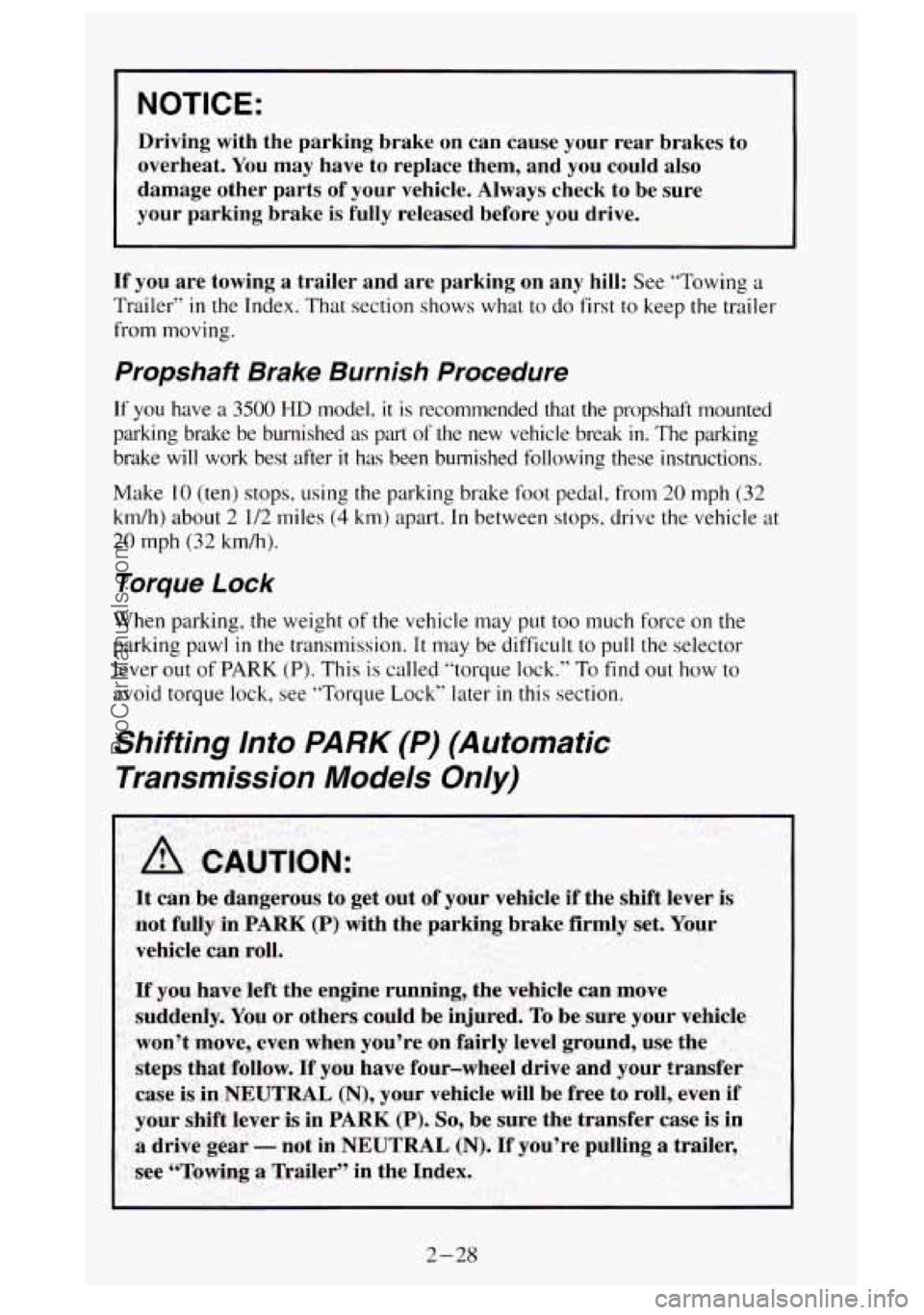
NOTICE:
Driving with the parking brake on can cause your rear brakes to
overheat. You may have to replace them, and you could also
damage other parts of your vehicle. Always check to be sure
your parking brake is fully released before you drive.
If you are towing a trailer and are parking on any hill: See “Towing a
Trailer” in the Index. That section shows what to do first to keep the trailer
from moving.
Propshaft Brake Burnish Procedure
If you have a 3500 HD model, it is recommended that the propshaft mounted
parking brake be burnished
as part of the new vehicle break in. The parking
brake will work best after
it has been burnished following these instructions.
Make
10 (ten) stops, using the parking brake foot pedal, from 20 mph (32
km/h) about
2 1/2 miles (4 km) apart. In between stops, drive the vehicle at
20 mph (32 km/h).
Torque Lock
When parking, the weight of the vehicle may put too much force on the
parking pawl
in the transmission. It may be difficult to pull the selector
lever out of
PARK (P). This is called ”torque lock.” To find out how to
avoid torque lock, see “Torque Lock” later in this section.
Shifting lnto PARK (P) (Automatic
Transmission Models Only)
2-28
ProCarManuals.com
Page 92 of 488
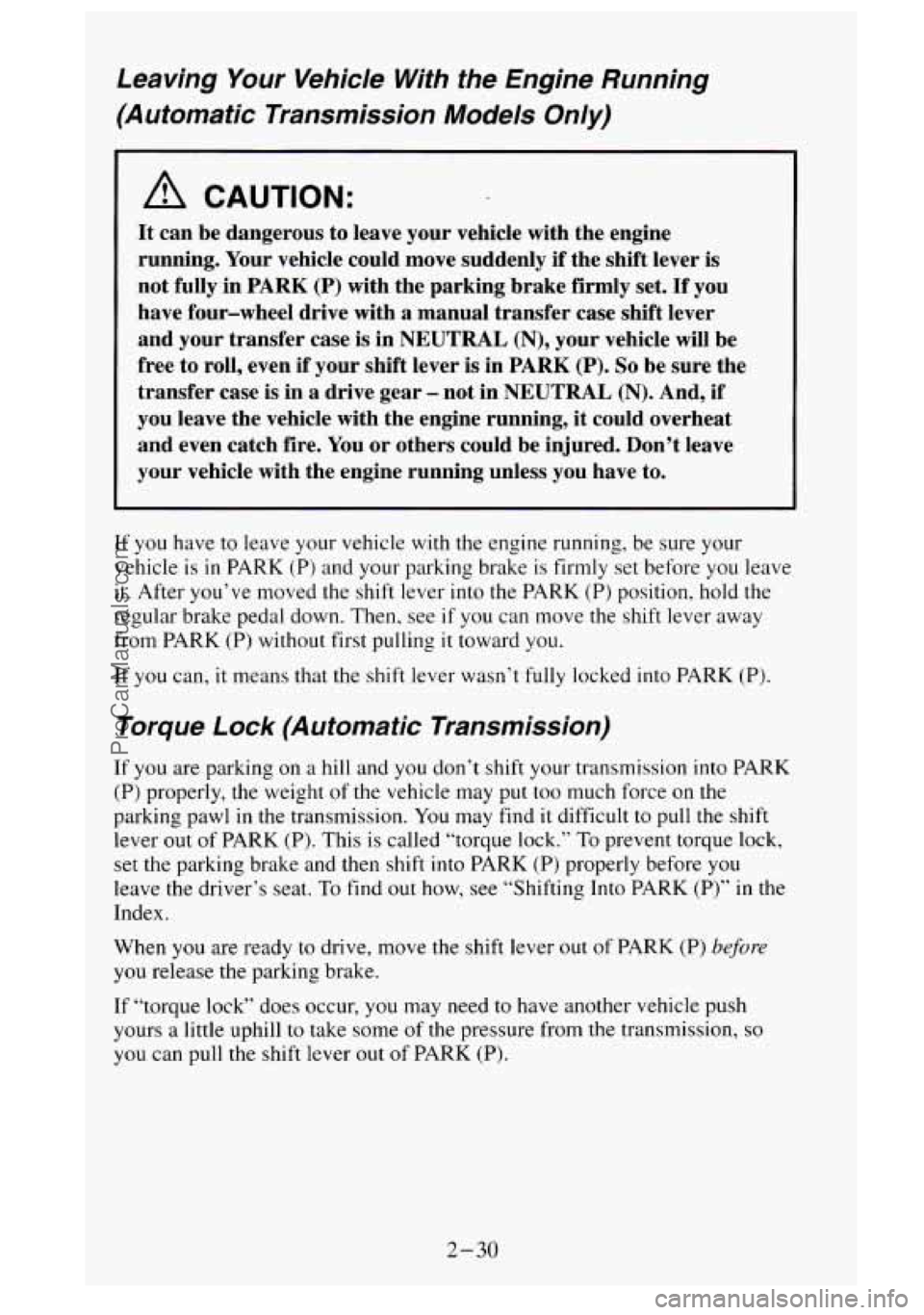
Leaving Your Vehicle With the Engine Running
(Automatic Transmission Models
Only)
A CAUTION:
It can be dangerous to leave your vehicle with the engine
running. Your vehicle could move suddenly if the shift lever
is
not fully in PARK (P) with the parking brake firmly set. If you
have four-wheel drive with a manual transfer case shift lever
and your transfer case is in
NEUTRAL (N), your vehicle will be
free to roll, even if your shift lever is in PARK
(P). So be sure the
transfer case
is in a drive gear - not in NEUTRAL (N). And, if
you leave the vehicle with the engine running, it could overheat
and even catch fire.
You or others could be injured. Don’t leave
your vehicle with the engine running unless you have to.
If you have to leave your vehicle with the engine running, be sure your
vehicle is in PARK (P) and your parking brake is firmly set before you leave
it. After you’ve moved the shift lever into the PARK (P) position, hold the
regular brake pedal down. Then. see
if you can move the shift lever away
from PARK (P) without first pulling
it toward you.
If
you can, it means that the shift lever wasn’t fully locked into PARK (P).
Torque Lock (Automatic Transmission)
If you are parking on a hill and you don’t shift your transmission into PARK
(P) properly, the weight of the vehicle may put too much force on the
parking pawl in the transmission.
You may find it difficult to pull the shift
lever out of PARK (P). This is called “torque lock.” To prevent torque lock,
set the parking brake and then shift into PARK (P) properly before you
leave the driver’s seat.
To find out how, see “Shifting Into PARK (P)” in the
Index.
When you are ready to drive, move the shift lever out
of PARK (P) before
you release the parking brake.
If “torque lock” does occur, you may need to have another vehicle push
yours
a little uphill to take some of the pressure from the transmission, so
you can pull the shift lever out of PARK (P).
2-30
ProCarManuals.com
Page 176 of 488
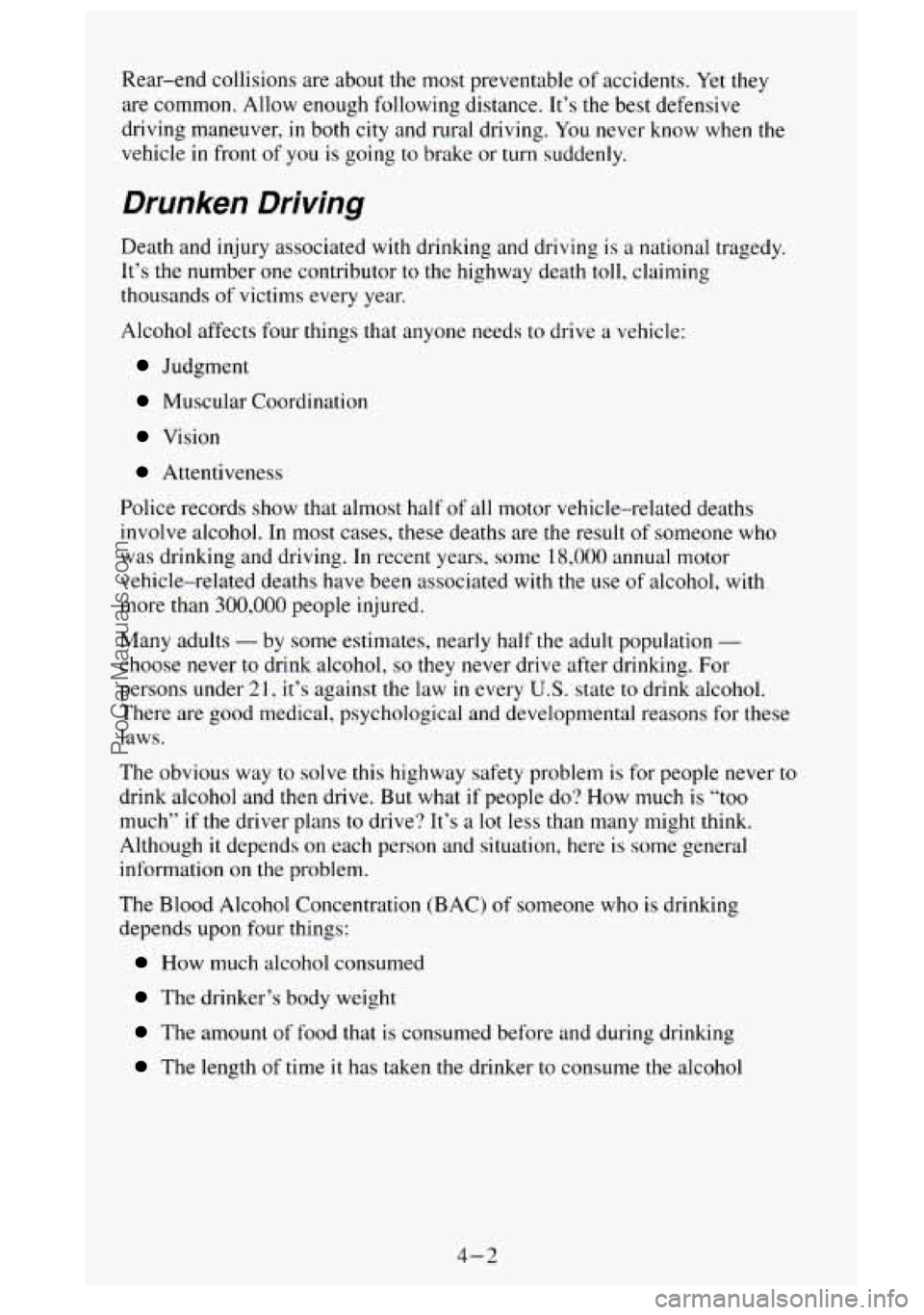
Rear-end collisions are about the most preventable of accidents. Yet they
are common. Allow enough following distance. It’s
the best defensive
driving maneuver, in both city and rural driving. You never know when the
vehicle in front of you is going to brake or turn suddenly.
Drunken Driving
Death and injury associated with drinking and driving is a national tragedy.
It’s the number one contributor to the highway death toll, claiming
thousands of victims every year.
Alcohol affects four things that anyone needs to drive
a vehicle:
Judgment
Muscular Coordination
Vision
Attentiveness
Police records show that almost half
of all motor vehicle-related deaths
involve alcohol. In most cases, these deaths are the result
of someone who
was drinking and driving. In recent years, some
18,000 annual motor
vehicle-related deaths have been associated with the use of alcohol, with
more than
300,000 people injured.
Many adults
- by some estimates, nearly half the adult population -
choose never to drink alcohol, so they never drive after drinking. For
persons under
2 I, it’s against the law in every U.S. state to drink alcohol.
There are good medical, psychological and developmental reasons for these
laws.
The obvious way to solve this highway safety problem
is for people never to
drink alcohol and then drive. But what if people do‘? How much is “too
much” if the driver plans to drive? It’s
a lot less than many might think.
Although
it depends on each person and situation, here is some general
information on the problem.
The Blood Alcohol Concentration (BAC)
of someone who is drinking
depends upon four things:
How much alcohol consumed
The drinker’s body weight
The amount of food that is consumed before and during drinking
The length of time it has taken the drinker to consume the alcohol
4-2
ProCarManuals.com
Page 177 of 488
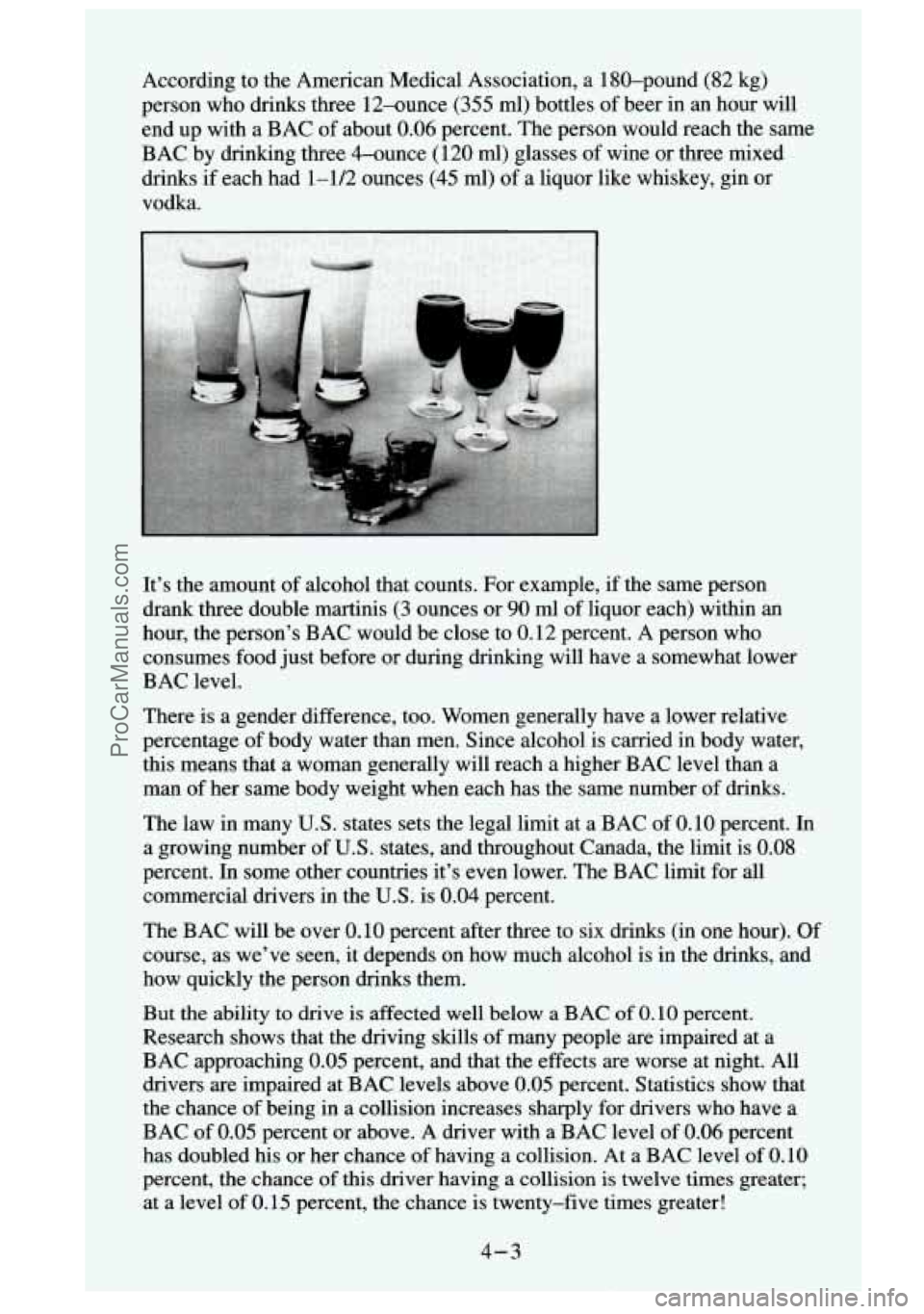
According to the American Medical Association, a 180-pound (82 kg)
person who drinks three 12-ounce (355 ml) bottles of beer in an hour will
end up with a BAC of about
0.06 percent. The person would reach the same
BAC, by drinking three 4-ounce (120
ml) glasses of wine or three mixed
drinks if each had 1-1/2 ounces (45 ml)
of a liquor like whiskey, gin or
vodka.
It’s the amount
of alcohol that counts. For example, if the same person
drank three double martinis
(3 ounces or 90 ml of liquor each) within an
hour, the person’s BAC would be close to 0.12 percent. A person who
consumes food just before or during drinking will have a somewhat lower
BAC level.
There is a gender difference, too. Women generally have a lower relative
percentage of body water than men. Since alcohol is carried in body water,
this means that a woman generally will reach a higher BAC level than a
man of her same body weight when each has the same number
of drinks.
The law in many
U.S. states sets the legal limit at a BAC of 0.10 percent. In
a growing number
of U.S. states, and throughout Canada, the limit is 0.08
percent. In some other countries it’s even lower. The BAC limit for all
commercial drivers in the
U.S. is 0.04 percent.
The BAC will be over 0.10 percent after three to six drinks (in one hour). Of
course, as we’ve seen, it depends on how much alcohol is in the drinks, and
how quickly the person
drinks them.
But the ability to drive
is affected well below a BAC of 0.10 percent.
Research shows that the driving skills
of many people are impaired at a
BAC approaching 0.05 percent, and that the effects are worse at night. All
drivers are impaired at BAC levels above 0.05 percent. Statisti\
cs show that
the chance of being in a collision increases sharply for drivers who have a
BAC of 0.05 percent or above. A driver with a BAC level
of 0.06 percent
has doubled his or her chance of having a collision. At a BAC level of 0.10
percent, the chance
of this driver having a collision is twelve times greater;
at a level
of 0.15 percent, the chance is twenty-five times greater!
4-3
ProCarManuals.com
Page 194 of 488
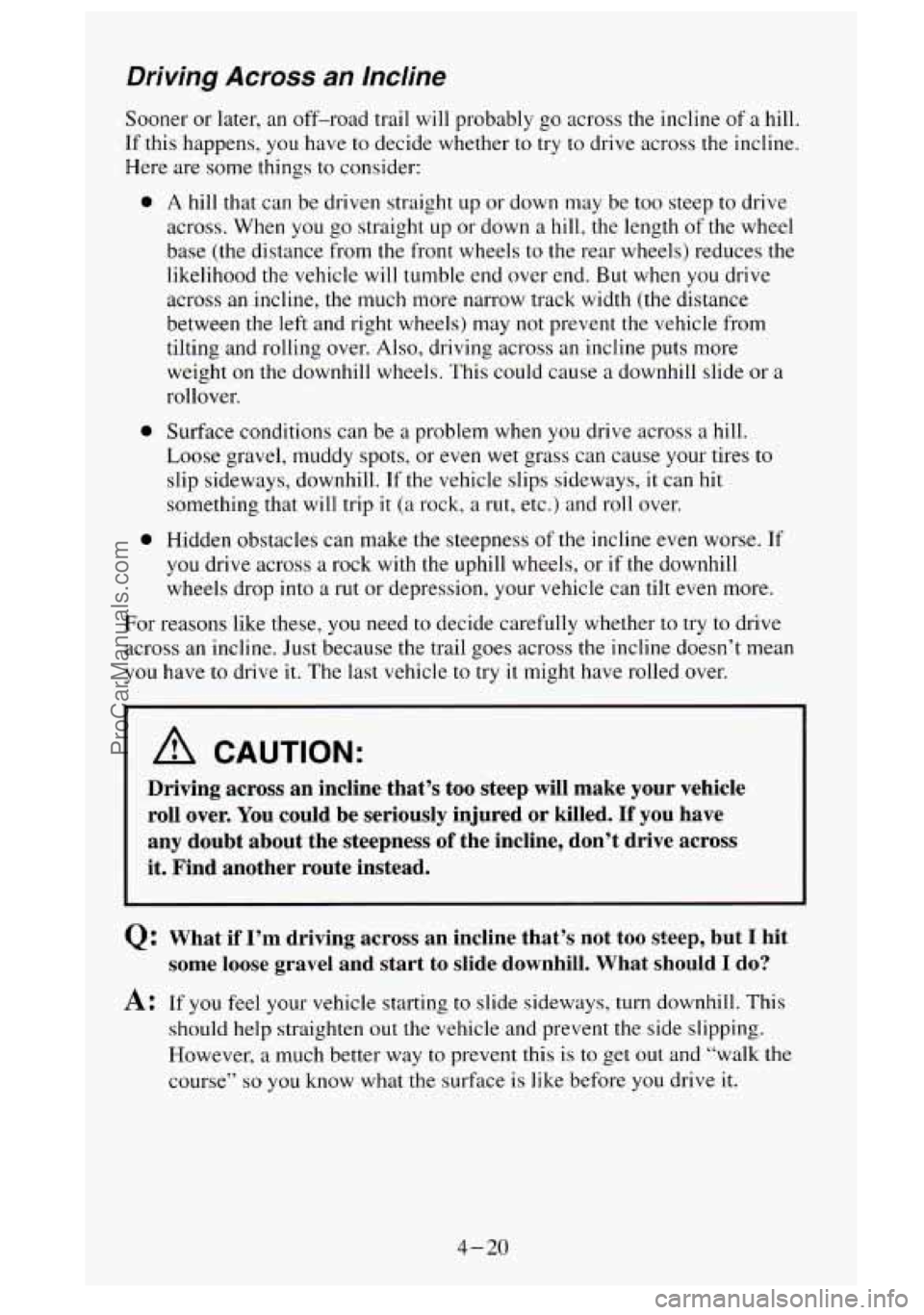
Driving Across an Incline
Sooner or later, an off-road trail will probably go across the incline of a hill.
If this happens, you have to decide whether to
try to drive across the incline.
0
0
0
~~
Here are some things to consider:
A hill that can be driven straight up or down may be too steep to drive
across. When you go straight up or down
a hill, the length of the wheel
base (the distance from the front wheels to the rear wheels) reduces the
likelihood the vehicle
will tumble end over end. But when you drive
across an incline, the much more narrow track width (the distance
between
the left and right wheels) may not prevent the vehicle from
tilting and rolling over. Also, driving across an incline puts more
weight on the downhill wheels. This could cause a downhill slide or
a
rollover.
Surface conditions can be
a problem when you drive across a hill.
Loose gravel, muddy spots, or even wet grass can cause your tires to
slip sideways, downhill. If the vehicle slips sideways, it can hit
something that will trip
it (a rock, a rut, etc.) and roll over.
Hidden obstacles can make the steepness
of the incline even worse. If
you drive across
a rock with the uphill wheels, or if the downhill
wheels drop into a
rut or depression, your vehicle can tilt even more.
For reasons like these,
you need to decide carefully whether to try to drive
across an incline. Just because the trail goes across the incline doesn’t mean
you have to drive it. The last vehicle to try it might have rolled over.
A CAUTION:
Driving across an incline that’s too steep will make your v\
ehicle
roll over.
You could be seriously injured or killed. If you have
any doubt about the steepness of the incline, don’t drive a\
cross
it. Find another route instead.
0: What if I’m driving across an incline that’s not too steep, but I hit
some loose gravel and start to slide downhill. What should
I do?
A: If you feel your vehicle starting to slide sideways, turn downhill. This
should help straighten
out the vehicle and prevent the side slipping.
However, a much better way
to prevent this is to get out and “walk the
course”
so you know what the surface is like before you drive it.
4 - 20
ProCarManuals.com
Page 211 of 488
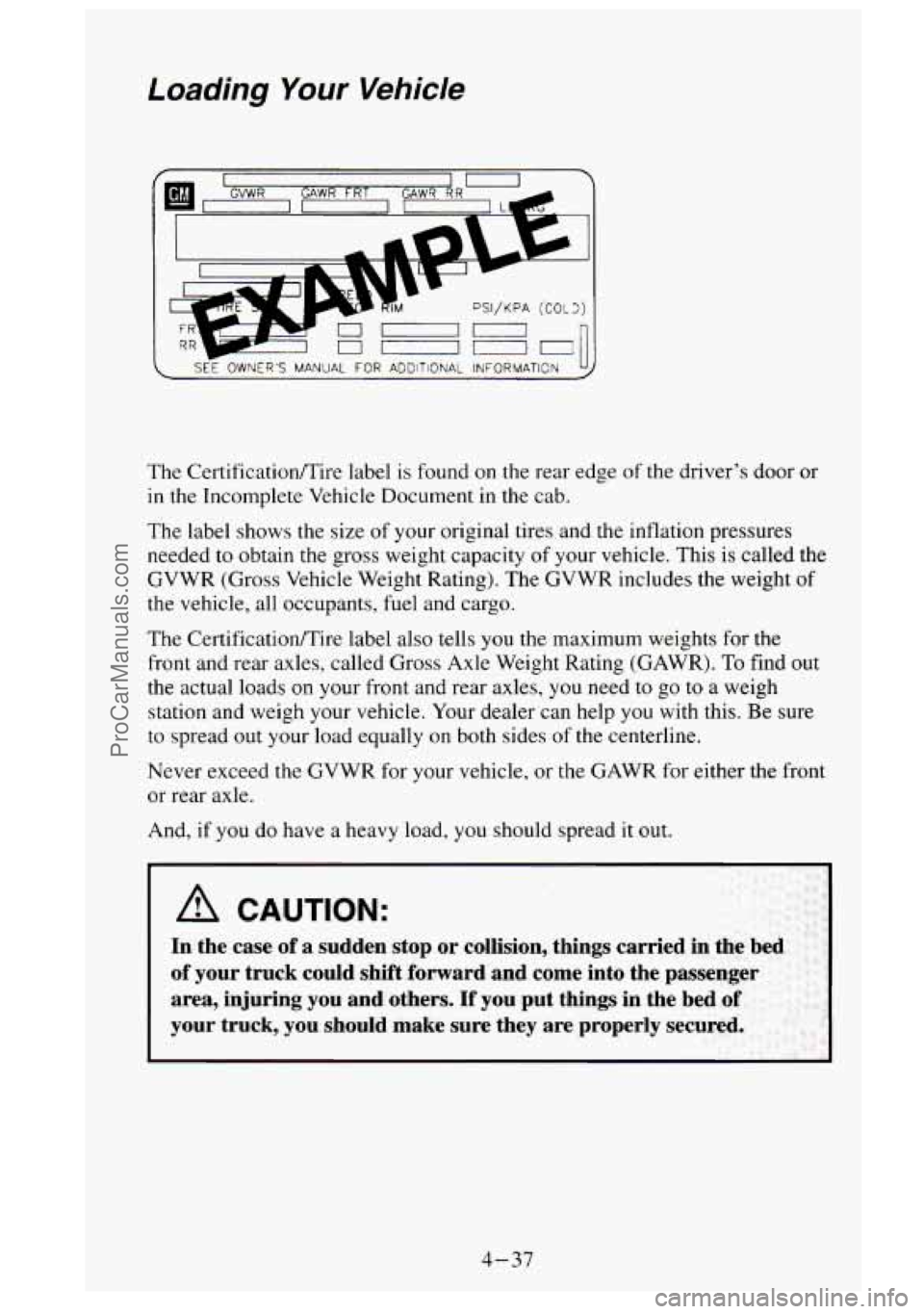
Loading Your Vehicle
-
DSI/KPA (COL3)
The Certification/Tire label is found on the rear edge of the driver’s door or
in the Incomplete Vehicle Document in the cab.
The label shows the size of your original tires and the inflation pressures
needed to obtain
the gross weight capacity of your vehicle. This is called the
GVWR (Gross Vehicle Weight Rating). The
GVWR includes the weight of
the vehicle, all occupants, fuel and cargo.
The CertificatiodTire label also tells you the maximum weights for the
front and rear axles, called Gross Axle Weight Rating (GAWR).
To find out
the actual loads
on your front and rear axles, you need to go to a weigh
station and weigh your vehicle. Your dealer can help
you with this. Be sure
to spread out your load equally on both sides of the centerline.
Never exceed the GVWR for your vehicle, or the GAWR for either the front
or rear axle.
And,
if you do have a heavy load, you should spread it out.
A CAUTION-:
In the case of a sudden stop or collision, things carried in the bed
of your truck could shift forward and come into the passenger \
area, injuring you and
others. If you put things in the bed of
your truck, you
should make sure they are properly secured.
4-37
ProCarManuals.com
Page 212 of 488

A CAUTION:
DO not load your vehicle any heavier than the GVWR, or either
the maximum front or rear
GAWR. If you do, parts on your
vehicle can break, or it can change the way your vehicle handles.
These could cause you to lose control. Also, overloading can
shorten the life
of your vehicle.
Using heavier suspension components to get added durability might not
change your weight ratings.
Ask your dealer to help you load your vehicle
the right way.
If your vehicle is equipped
for front-end equipment (a snow plow, for
example), the front suspension may have been adjusted (raised) to level the
vehicle when the equipment was installed. If the front suspension was
adjusted,
you must re-adjust the front suspension after the equipment is
removed to avoid possible front suspension damage. Adjust the front
suspension to original design specifications for your particular model.
NOTICE:
Your warranty does not cover parts or components that fail
because
of overloading.
There’s also important loading information for off-road driving in this
manual. See “Loading
Your Vehicle“ in the Index.
4-38
ProCarManuals.com
Page 214 of 488

This label will tell you how much of a load your vehicle can carry, and how
to spread out your load the right way. Also, it will help you match the right
slide-in camper
to your vehicle.
When you carry a slide-in camper, the total cargo load
of your vehicle is the
weight of the camper,
PLUS
everything else added to the camper after it left the factory;
everything in the camper; and
all the people inside.
The Cargo Weight Rating (CWR) is the maximum weight of
the load your
vehicle can carry.
It doesn’t include the weight of the people inside. But,
you can figure about 150 pounds for each seat.
The total cargo load must not be more than your vehicle’s CWR.
TRUCK LOADING INFORMATION
1. Recommended
location
for cargo
center
of gravity
for cargo weight
rating (Pickup
Truck)
.
Refer to the Truck Camper Loading Information label in glove box for
“A”and
“B” dimensions. Use the rear edge of the load floor for
measurement purposes.
4-40
ProCarManuals.com